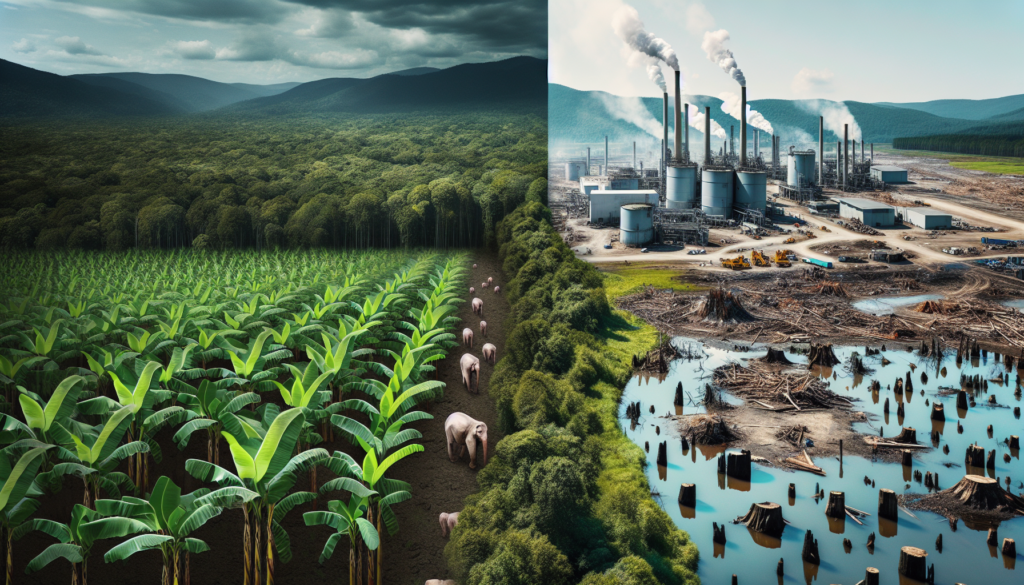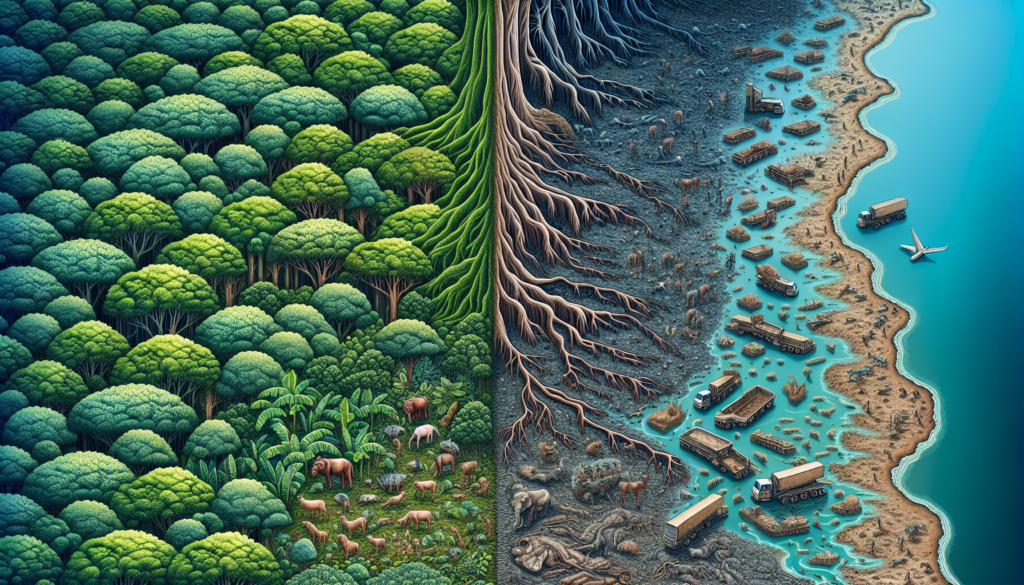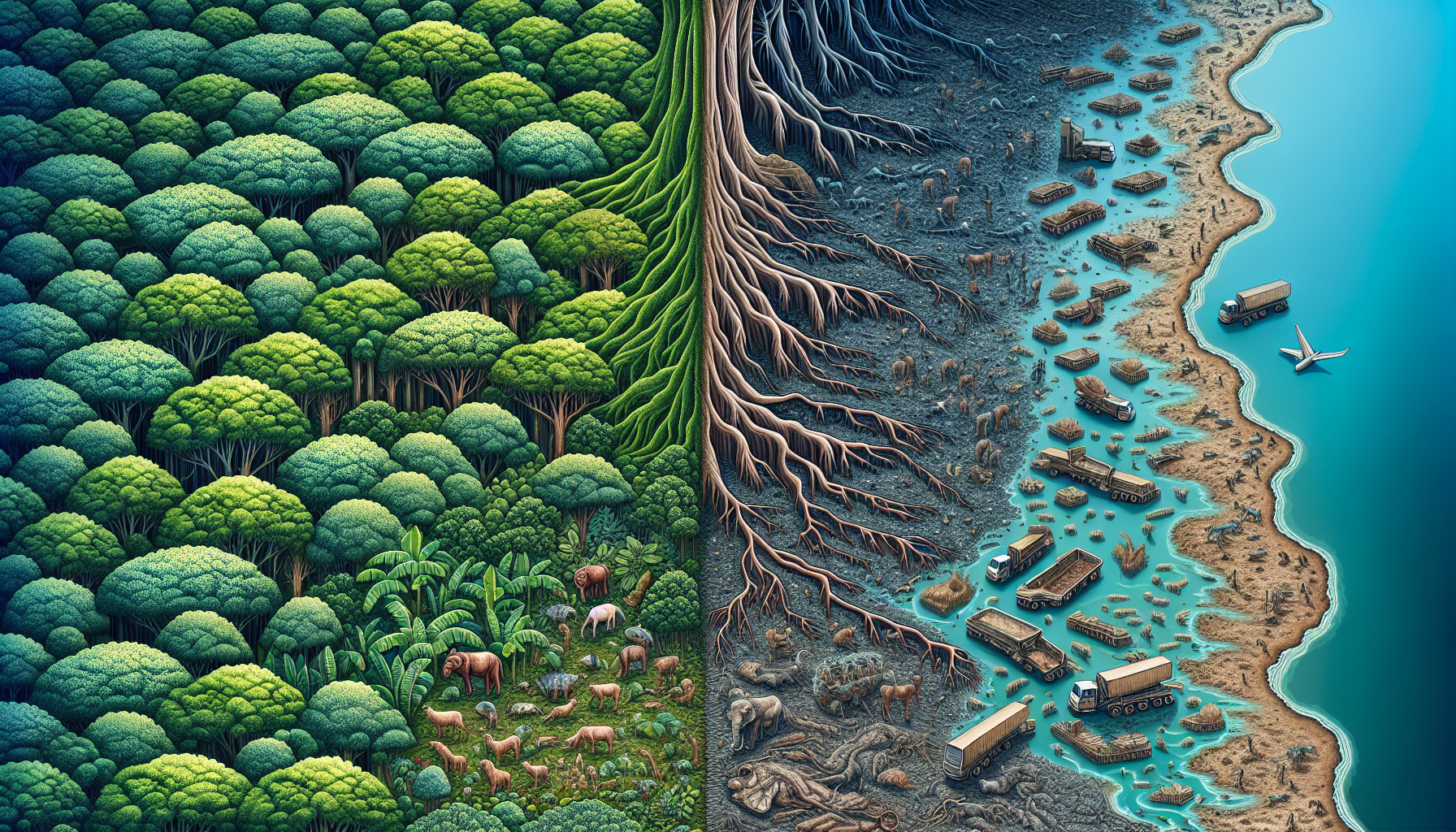Imagine a world where sustainable living is the norm, where we prioritize the well-being of our planet alongside our own. In this pursuit, it becomes essential to address the environmental impact of meat production. As we sit down to enjoy our favorite juicy steaks and succulent burgers, it’s easy to overlook the immense strain this industry puts on our planet. From deforestation to greenhouse gas emissions, the consequences of meat production are far-reaching. Join us as we uncover the hidden truths behind this pressing issue and explore the ways in which we can make a positive change for our environment.

Water Usage
Water consumption in animal agriculture
One of the significant environmental concerns related to meat production is the immense amount of water utilized in animal agriculture. The process of rearing livestock requires copious amounts of water for various purposes, including drinking, food production, and sanitation. Animals raised for meat consume vast quantities of water throughout their lifetime, especially when considering the water-demanding feed crops needed to sustain them. This substantial water consumption in animal agriculture puts a strain on global freshwater resources and exacerbates water scarcity issues in many regions.
Water pollution from factory farming
Another adverse consequence of meat production is water pollution resulting from factory farming practices. The intensive and concentrated nature of industrial livestock farming leads to the accumulation of an excessive amount of animal waste, including manure and urine. When this waste is not properly managed, it can seep into nearby bodies of water, contaminating them with harmful pathogens, nutrients, and chemicals. This water pollution not only threatens aquatic ecosystems but also poses health risks to humans who rely on these water sources.
Depletion of water resources
Additionally, meat production contributes to the depletion of water resources, particularly through the cultivation of feed crops. Livestock farming requires vast areas of land dedicated to growing crops such as corn and soy, which necessitate substantial irrigation. As a result, large amounts of water are withdrawn from freshwater sources, depleting aquifers and surface water reserves. This depletion further strains water availability for other sectors and ecosystems, exacerbating the global water crisis.
Deforestation
Clearing of forests for livestock grazing
Meat production is a significant driver of deforestation worldwide, primarily through the clearing of forests for livestock grazing. Forested lands, which are rich in biodiversity and crucial for carbon sequestration, are often bulldozed or burned down to make way for expansive pastures to rear cattle and other animals. These destructive practices not only rob the planet of its lush green cover but also contribute to the release of massive carbon emissions, worsening the climate crisis.
Conversion of forests into feed crops
Moreover, forests are frequently converted into vast monocultures of feed crops, primarily used as animal feed. To meet the growing demand for meat, large areas of land are converted into agricultural fields, leading to the loss of precious forest ecosystems. This conversion not only accelerates deforestation rates but also disrupts the delicate balance of biodiversity. The destruction and fragmentation of habitats harm countless plant and animal species, driving them towards extinction.
Loss of biodiversity
The environmental impact of meat production extends beyond deforestation to the loss of biodiversity. The destruction of forests and conversion of natural landscapes into agricultural areas contribute to the loss of habitat for various flora and fauna. Species relying on these habitats face the increased risk of extinction as their homes are destroyed. Additionally, the disruption of ecosystems due to meat production disturbs the intricate web of interactions between species, leading to imbalances and potentially cascading negative effects throughout the environment.
Greenhouse Gas Emissions
Contribution of livestock to greenhouse gas emissions
Meat production significantly contributes to greenhouse gas emissions, making it a significant driver of climate change. The rearing and processing of livestock release substantial amounts of methane, carbon dioxide, and nitrous oxide, which are potent greenhouse gases. The carbon footprint of meat production is primarily attributed to enteric fermentation (the process of digestion in the animal’s stomach), manure management, and the use of fossil fuels in transportation and processing.
Methane emissions from enteric fermentation
Enteric fermentation in the digestive systems of ruminant animals, such as cattle, results in the production of methane. Methane is a highly potent greenhouse gas, with a warming potential much higher than carbon dioxide. As livestock farming has expanded to meet rising meat consumption, the population of ruminant animals has increased, leading to a significant increase in methane emissions. These emissions contribute to the intensification of global warming and the acceleration of climate change.
Deforestation as a result of meat production
Meat production also indirectly contributes to greenhouse gas emissions through deforestation. As mentioned earlier, the clearance of forests for livestock grazing and feed crop cultivation releases large amounts of carbon dioxide into the atmosphere. Forests act as carbon sinks, absorbing carbon dioxide from the atmosphere and storing it in trees and vegetation. However, when forests are destroyed, this stored carbon is released back into the air, exacerbating the greenhouse effect and climate change.
Land Usage
Conversion of natural landscapes into animal farming areas
The expansion of animal farming necessitates the conversion of natural landscapes into vast areas dedicated to raising livestock. Pristine ecosystems, such as grasslands and forests, are cleared or modified to create space for animal housing, pastures, and infrastructure. This conversion of land disrupts the natural balance of ecosystems and leads to the loss of vital ecological functions. It further fragments habitats and isolates species, making them more vulnerable to extinction.
Expansion of feed crop cultivation
To meet the demand for animal feed, vast expanses of land are dedicated to the cultivation of feed crops, exacerbating the environmental impact of meat production. The expansion of feed crop cultivation not only leads to the destruction of natural habitats but also contributes to soil degradation and water scarcity. Additionally, the intensification of feed crop cultivation often requires the excessive use of pesticides, fertilizers, and irrigation, further polluting ecosystems and degrading soil health.
Loss of natural habitats
The conversion of land for meat production results in the loss of natural habitats for numerous species. The destruction and fragmentation of habitats disrupt the natural balance of ecosystems, leading to the displacement and endangerment of many plant and animal species. From large predators to small insects, countless organisms suffer from the loss of their homes and the subsequent challenges in finding suitable alternatives. This loss of natural habitats has far-reaching consequences for biodiversity and the overall health of the planet.

Soil Degradation
Overgrazing and soil erosion
Livestock farming, particularly through overgrazing, contributes to soil degradation and erosion. When animals graze excessively and repeatedly in a specific area, they deplete the grass and vegetation cover, leaving the soil exposed. This vulnerability increases the risk of erosion, as wind and water can easily carry away the topsoil. Soil erosion not only diminishes the fertility of the land but also results in sediment runoff, which can clog water bodies and harm aquatic ecosystems.
Pollution from manure and fertilizers
The extensive use of manure and chemical fertilizers in meat production creates pollution risks for soil and water. The improper handling and management of animal waste, such as manure, can lead to its runoff into nearby soils and water bodies. When released into the environment, these pollutants can contaminate soils, impairing their fertility and disrupting the natural nutrient cycles. Furthermore, the excessive application of chemical fertilizers contributes to water pollution, especially when these substances reach nearby streams, rivers, and lakes.
Loss of soil fertility
The intensive nature of meat production, coupled with unsustainable agricultural practices, results in the loss of soil fertility. Continuous cultivation without adequate rest or crop rotation depletes essential nutrients from the soil, diminishing its capacity to support plant growth. Additionally, the reliance on chemical fertilizers, which often contain high levels of nitrogen, can lead to imbalances in soil pH and nutrient availability. These factors collectively contribute to diminishing soil quality, making it less suitable for future agricultural use and threatening long-term food security.
Waste Management
Vast amounts of animal waste
The immense scale of meat production leads to the generation of vast amounts of animal waste, presenting significant challenges in waste management. Industrial livestock farming facilities, often termed factory farms, house large populations of animals in confined spaces, generating substantial quantities of urine and feces. The accumulation of this waste poses environmental risks, including water and air pollution, as well as the potential for the spread of disease. Proper waste management systems are essential to mitigate these adverse effects and prevent contamination of surrounding environments.
Contamination of water bodies
Inadequate waste management practices in meat production can result in the contamination of nearby water bodies. Animal waste contains harmful pathogens and excessive nutrients, such as nitrogen and phosphorus, which can leach into the soil and ultimately find their way into rivers, lakes, and groundwater. The introduction of these pollutants into water bodies can lead to eutrophication, causing algal blooms, oxygen depletion, and the degradation of aquatic ecosystems. Additionally, the release of pollutants into water sources threatens the availability of clean water for human consumption and agricultural use.
Health risks and pollution
The improper management of animal waste in meat production not only poses environmental risks but also jeopardizes human health. The release of pollutants, such as ammonia and hydrogen sulfide, into the air from manure lagoons and storage facilities can contribute to air pollution and unpleasant odors. Exposure to these pollutants has been linked to respiratory problems, eye irritation, and other adverse health effects. Moreover, the spread of pathogens present in animal waste can pose significant risks to human health, especially in communities living in close proximity to livestock operations.
Biodiversity Loss
Impact on local flora and fauna
Meat production has a substantial impact on local flora and fauna, contributing to the loss of biodiversity. The conversion of natural habitats for animal farming reduces the availability of suitable areas for native plant species, leading to their decline or eradication. As plant populations decrease, animals relying on these plants for food and shelter also suffer, potentially leading to population declines and local extinctions. The disruption of ecological interactions and the loss of biodiversity have cascading effects on the health and resilience of ecosystems.
Species extinction due to habitat destruction
The destruction and fragmentation of habitats for meat production put numerous plant and animal species at risk of extinction. Forests, grasslands, and other ecosystems are cleared or modified to create space for livestock and feed crop cultivation, depriving countless species of their homes and critical resources. The loss of habitat disrupts species’ life cycles, migration patterns, and reproductive habits, making it increasingly difficult for them to survive and thrive. The continued expansion of meat production poses a severe threat to global biodiversity and the preservation of Earth’s rich and irreplaceable species.
Disruption of ecosystems
The far-reaching consequences of meat production extend to the disruption of ecosystems. The removal or alteration of key species within these ecosystems can have profound effects on their functioning and stability. Predators play crucial roles in maintaining balanced populations by keeping herbivore populations in check, preventing overgrazing and ecosystem degradation. Additionally, the loss of keystone species, which have disproportionate effects on their environment, can lead to a domino effect, with widespread disruptions in ecological processes and interactions.
Antibiotic Resistance
Excessive use of antibiotics in livestock
The excessive use of antibiotics in livestock farming contributes to the development and spread of antibiotic-resistant bacteria, posing a significant threat to human health. Antibiotics are commonly used in meat production to promote growth and prevent diseases in crowded and unsanitary conditions. However, the overuse and misuse of antibiotics in animals can lead to the emergence of drug-resistant bacterial strains, making infections harder to treat in both animals and humans.
Development of antibiotic-resistant bacteria
The use of antibiotics in meat production creates an environment conducive to the development of antibiotic-resistant bacteria. Continuous exposure to low doses of antibiotics allows bacteria to adapt and develop resistance mechanisms, rendering these drugs ineffective. When these bacteria spread to humans through contaminated food products or direct contact, they can cause infections that are difficult or impossible to treat with standard antibiotics. This growing threat of antibiotic resistance poses a public health crisis and highlights the urgent need for responsible antibiotic use in livestock farming.
Threat to human health
The emergence and spread of antibiotic-resistant bacteria in meat production present significant risks to human health. When people consume contaminated meat products or come into contact with resistant bacteria, they can experience severe infections that are more challenging to treat. These infections can lead to prolonged hospitalization, increased healthcare costs, and even death. The loss of effective antibiotics in treating common illnesses and infections due to antibiotic resistance poses a grave threat to global public health, emphasizing the need for sustainable and responsible practices in meat production.
Eutrophication
Runoff of nutrients into water bodies
Meat production contributes to eutrophication, a process in which water bodies become excessively enriched with nutrients, usually nitrogen and phosphorus. The excessive application of fertilizers in feed crop cultivation and the release of animal waste can lead to nutrient runoff into nearby water bodies. When these nutrients enter aquatic ecosystems, such as rivers and lakes, they promote the rapid growth of algae and other aquatic plants, leading to algal blooms.
Algal blooms and dead zones
Algal blooms, caused by eutrophication, can have severe ecological consequences. The excessive growth of algae blocks sunlight from reaching other aquatic plants, leading to reduced oxygen levels and the death of underwater organisms. As algae die and decompose, bacteria consume the available oxygen, creating oxygen-depleted zones known as dead zones. Dead zones are uninhabitable for most aquatic species and can lead to mass fish kills and the collapse of entire ecosystems.
Destruction of aquatic ecosystems
The eutrophication resulting from meat production poses a significant threat to aquatic ecosystems. The imbalance in nutrient levels disrupts the natural dynamics of freshwater and marine environments, leading to the loss of biodiversity and the degradation of habitats. The destruction of aquatic ecosystems not only impairs their ability to provide valuable ecosystem services but also compromises the livelihoods and food security of communities reliant on fishing and other water-based activities.
Water Footprint
Large amount of water required to produce meat
Meat production has a substantial water footprint, meaning it requires a significant amount of water throughout the entire production process. From the watering of animals to the irrigation of feed crops and the processing and transportation of meat products, water plays a vital role. Livestock farming, particularly the rearing of cattle, requires vast amounts of water to sustain the animals and grow the feed crops they consume. The water footprint of meat production reflects the immense pressure placed on freshwater resources and the urgency to adopt more sustainable dietary choices.
Comparison with plant-based protein sources
The water footprint of meat production is considerably higher compared to plant-based protein sources. Growing plant-based crops, such as legumes and grains, generally requires less water compared to growing feed crops for livestock. Additionally, plant-based proteins require fewer resources and emit fewer greenhouse gases throughout their production compared to meat. By transitioning to diets rich in plant-based proteins, individuals can significantly reduce their water footprint and contribute to overall water conservation efforts.
Water scarcity implications
The substantial water requirements of meat production have significant implications for water scarcity, particularly in regions already experiencing water stress. As the global population grows and the demand for meat increases, the strain on freshwater resources intensifies. The competition for water between agriculture, industry, and households becomes more pronounced, exacerbating the scarcity of clean and accessible water. Addressing the water scarcity implications of meat production necessitates adopting more efficient and sustainable agricultural practices, as well as promoting dietary changes that reduce meat consumption.
In conclusion, the environmental impact of meat production encompasses various interconnected issues that pose significant challenges to the health of our planet. From excessive water usage to deforestation, greenhouse gas emissions, and loss of biodiversity, the negative consequences extend across multiple ecosystems and global resources. Recognizing the environmental implications of meat consumption and taking action through sustainable practices and dietary choices can contribute to the preservation of our planet and the well-being of current and future generations.

